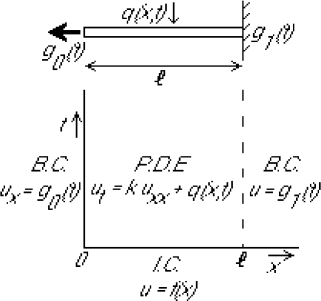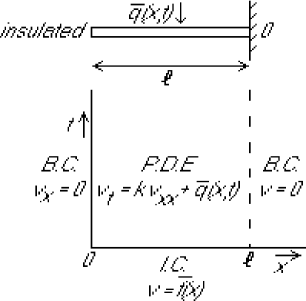Find Particular and Homogeneous Solution to Boundary Value Problem Fourier
| Partial Differential Equations 0.15 alpha | © Leon van Dommelen |
- 5.6.1 The physical problem
- 5.6.2 The mathematical problem
- 5.6.3 Outline of the procedure
- 5.6.4 Step 0: Fix the boundary conditions
- 5.6.5 Step 1: Find the eigenfunctions
- 5.6.6 Step 2: Solve the problem
- 5.6.7 Summary of the solution
5.6 Inhomogeneous boundary conditions
The method of separation of variables needs homogeneous boundary conditions. More precisely, the eigenfunctions must have homogeneous boundary conditions. (Even if in a set of functions each function satisfies the given inhomogeneous boundary conditions, a combination of them will in general not do so.)
In the previous example, this problem could be circumvented by choosing ![]() instead of
instead of ![]() as the variable of the eigenfunctions. For the example in this section, however, this does not work.
as the variable of the eigenfunctions. For the example in this section, however, this does not work.
5.6.1 The physical problem
The problem is to find the unsteady temperature distribution in a bar for any arbitrary position ![]() and time
and time ![]() . The initial temperature distribution at time zero equals a given function
. The initial temperature distribution at time zero equals a given function ![]() . The heat flux out of the left end equals a given function
. The heat flux out of the left end equals a given function ![]() , and the temperature of the right end a given function
, and the temperature of the right end a given function ![]() . Heat is added to the bar from an external source at a rate described by a given function
. Heat is added to the bar from an external source at a rate described by a given function ![]() .
.
 |
5.6.2 The mathematical problem
 |
5.6.3 Outline of the procedure
We would like to use separation of variables to write the solution in a form that looks roughly like:
![]()
Here the
The ![]() cannot be eigenfunctions since the time axis is semi-infinite. Also, Sturm-Liouville problems require boundary conditions at both ends, not initial conditions.
cannot be eigenfunctions since the time axis is semi-infinite. Also, Sturm-Liouville problems require boundary conditions at both ends, not initial conditions.
Unfortunately, eigenfunctions must have homogeneous boundary conditions. So if ![]() was simply written as a sum of eigenfunctions, it could not satisfy inhomogeneous boundary conditions.
was simply written as a sum of eigenfunctions, it could not satisfy inhomogeneous boundary conditions.
Fortunately, we can apply a trick to get around this problem. The trick is to write ![]() as the sum of a function
as the sum of a function ![]() that satisfies the inhomogeneous boundary conditions plus a remainder
that satisfies the inhomogeneous boundary conditions plus a remainder ![]() :
:
![]()
Since
![]()
using separation of variables. Add
5.6.4 Step 0: Fix the boundary conditions
The first thing to do is find a function ![]() that satisfies the same boundary conditions as
that satisfies the same boundary conditions as ![]() . In particular,
. In particular, ![]() must satisfy:
must satisfy:
![]()
The function ![]() does not have to satisfy the either the partial differential equation or the initial condition. That allows you to take something simple for it. The choice is not unique, but you want to select something simple.
does not have to satisfy the either the partial differential equation or the initial condition. That allows you to take something simple for it. The choice is not unique, but you want to select something simple.
A function that is linear in ![]() ,
,
![]()
is surely the simplest possible choice. In this example, it works fine too.
Plug this expression for ![]() into the boundary conditions for
into the boundary conditions for ![]() ,
,
![]()
That produces the requirements
![]()
The solution is
![]()
Keep track of what we know, and what we do not know. Since we (supposedly) have been given functions ![]() and
and ![]() , function
, function ![]() is from now on considered a known quantity, as given above.
is from now on considered a known quantity, as given above.
You could use something more complicated than a linear function if you like to make things difficult for yourself. Go ahead and use ![]() if you really love to integrate error functions and Bessel functions. It will work. I prefer a linear function myself, though. (For some problems, you may need a quadratic instead of a linear function.)
if you really love to integrate error functions and Bessel functions. It will work. I prefer a linear function myself, though. (For some problems, you may need a quadratic instead of a linear function.)
Under certain conditions, there may be a better choice than a low order polynomial in ![]() . If the problem has steady boundary conditions and a simple steady solution, go ahead and take
. If the problem has steady boundary conditions and a simple steady solution, go ahead and take ![]() to be that steady solution. It will work great. However, in the example here the boundary conditions are not steady; we are assuming that
to be that steady solution. It will work great. However, in the example here the boundary conditions are not steady; we are assuming that ![]() and
and ![]() are arbitrary given functions of time.
are arbitrary given functions of time.
Next, having found ![]() , define a new unknown
, define a new unknown ![]() as the remainder when
as the remainder when ![]() is subtracted from
is subtracted from ![]() :
:
![]()
We now solve the problem by finding
To do so, first, of course, we need the problem for ![]() to solve. We get it from the problem for
to solve. We get it from the problem for ![]() by everywhere replacing
by everywhere replacing ![]() by
by ![]() . Let's take the picture of the problem for
. Let's take the picture of the problem for ![]() in front of us and start converting.
in front of us and start converting.
 |
First take the boundary conditions at ![]() and
and ![]() :
:
![]()
Replacing
![]()
But since by construction
![]()
Note the big thing: while the boundary conditions for
We continue finding the rest of the problem for ![]() . We replace
. We replace ![]() by
by ![]() into the partial differential equation
into the partial differential equation ![]() ,
,
![]()
and take all
![]()
where
![]()
Hence
The final part of the problem for ![]() that we have not converted yet is the initial condition. We replace
that we have not converted yet is the initial condition. We replace ![]() by
by ![]() in
in ![]() ,
,
![]()
and take
![]()
where
![]()
Again,
The problem for ![]() is now the same as the one for
is now the same as the one for ![]() , except that the boundary conditions are homogeneous and functions
, except that the boundary conditions are homogeneous and functions ![]() and
and ![]() have changed into known functions
have changed into known functions ![]() and
and ![]() .
.
Using separation of variables, we can find the solution for ![]() in the form:
in the form:
![]()
We already know how to do that! (Don't worry, we will go over the steps anyway.) Having found
5.6.5 Step 1: Find the eigenfunctions
To find the eigenfunctions ![]() , substitute a trial solution
, substitute a trial solution ![]() into the homogeneous part of the partial differential equation,
into the homogeneous part of the partial differential equation, ![]() . Remember: ignore the inhomogeneous part
. Remember: ignore the inhomogeneous part ![]() when finding the eigenfunctions. Putting
when finding the eigenfunctions. Putting ![]() into
into ![]() produces:
produces:
![]()
Separate variables:
![]()
As always,
We then get the following Sturm-Liouville problem for any eigenfunctions ![]() :
:
![]()
The last two equations are the boundary conditions on
This is the exact same eigenvalue problem that we had in an earlier example, so I can just take the solution from there. The eigenfunctions are:

5.6.6 Step 2: Solve the problem
We expand in the problem for ![]() in a Fourier series:
in a Fourier series:
 |
In particular,

Since ![]() and
and ![]() are known functions, we can find their Fourier coefficients from orthogonality:
are known functions, we can find their Fourier coefficients from orthogonality:


or with the eigenfunctions written out


The integrals in the bottom equal
So the Fourier coefficients ![]() are now known constants, and the
are now known constants, and the ![]() are now known functions of
are now known functions of ![]() . Though in actual application, numerical integration may be needed to find them. During finals, I usually make the functions
. Though in actual application, numerical integration may be needed to find them. During finals, I usually make the functions ![]() ,
, ![]() and
and ![]() simple enough that you can do the integrals analytically.
simple enough that you can do the integrals analytically.
Now write the partial differential equation ![]() using the Fourier series:
using the Fourier series:

Looking in the previous section, the Sturm-Liouville equation was

It will always simplify or you made a mistake.
For the sums to be equal for any ![]() , the coefficients of every individual eigenfunction must balance. So we get
, the coefficients of every individual eigenfunction must balance. So we get
![]()
We have obtained an ordinary differential equation for each
Solve the homogeneous equation first. The characteristic polynomial is
![]()
so the homogeneous solution is
![]()
For the inhomogeneous equation, undetermined constants is not a possibility since we do not know the actual form of the functions ![]() . So we use variation of parameter:
. So we use variation of parameter:
![]()
Plugging into the ordinary differential equation produces
![]()
We integrate this equation to find
![]()
But that has the problem that the integration constant is not explicitly shown. That makes it impossible to apply the initial condition. It is better to write the anti-derivative using an integral with limits plus an explicit integration constant as:
![]()
You can check using the Leibniz rule for differentiation of integrals (or really, just the fundamental theorem of calculus,) that the derivative is exactly what it should be. (Also, the lower limit does not really have to be zero; you could start the integration from 1, if it would be simpler. The important thing is that the upper limit is the independent variable
Putting the found solution for ![]() into
into
![]()
we get, cleaned up:
![]()
We still need to find the integration constant ![]() . To do so, write the initial condition
. To do so, write the initial condition ![]() using Fourier series:
using Fourier series:

This gives us initial conditions for the
![]()
the latter from above, and hence
![]()
or writing out the eigenvalue:

We have
5.6.7 Summary of the solution
Collecting all the boxed formulae together, the solution is found by first computing the coefficients ![]() from:
from:
![]()
where
![]()
Also compute the functions ![]() from:
from:
![]()
where
![]()
Then the temperature is:
![\begin{displaymath} \begin{array}{l} \displaystyle u(x,t)_{\strut} = g_1(t... ...ll^2} \right] \cos\frac{(2n-1)\pi x}{2\ell} \end{array} \end{displaymath}](https://eng-web1.eng.famu.fsu.edu/~dommelen/pdes/style_a/img1176.gif)
Find Particular and Homogeneous Solution to Boundary Value Problem Fourier
Source: https://eng-web1.eng.famu.fsu.edu/~dommelen/pdes/style_a/svbex.html